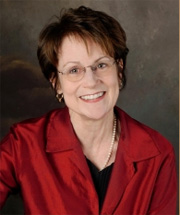Teaming up with your Primary Care PhysicianPowerful Patient, 2008 Week 28Joyce Graff, host, on webtalkradio.net Beginning July 7, 2008
Dr. Phyllis Hollenbeck talks about how a Primary Care Physician can be the key member of your health care team, helping to treat the whole person and coordinate the input of various specialists. Examples include diagnosing headaches and Lyme disease.
About Our Guest
Phyllis Hollenbeck has been a Family Physician for thirty years and is the author of Sacred Trust. She is an honors graduate of Brown University, as well as its medical school. The product of a combined liberal arts premedical program, she remains a shameless proponent of this type of “well-rounded” education for physicians. She chose Family Medicine as her specialty, and her career has encompassed solo and group practice, academic teaching, and administrative leadership – with the common thread of working to make medicine do its best.
Board-certified and a Fellow of the American Academy of Family Physicians, Dr. Hollenbeck currently mothers three children, makes music, puts mind to laptop, and sees patients outside of Washington, DC. Dr. Phyllis Hollenbeck’s website can be found at http://www.hollenbeckmd.com.
When to Fire Your Doctor
Dr. Hollenbeck feels strongly that consumers must demand the same quality service from their health care providers that they expect in other areas of their life.
From the moment people walk into their doctor’s office, they immediately play a subservient role. The American Medical Association says that each patient waits an average of 20 minutes before their physician sees them. Once in their presence, the average doctor – specialized or not – spends just seven minutes in total with the patient and only allows an average of 18 seconds to explain the symptoms before they interrupt.
“Medicine is a service profession,” says Dr. Hollenbeck, author of the book, Sacred Trust: The Ten Rules of Life, Death, and Medicine. “It should be a humbling experience to have the chance to be a physician – not a passport to arrogance.”
“Many patients feel they have no power in a doctor’s office,” Dr. Hollenbeck says, “but in fact they hold all the power. They are employing the doctor, and have every right to, in effect, fire them if they are not satisfied with the service being provided.”
The patient empowerment advocated in Sacred Trust is completely congruent with the Powerful Patient’s Eight Ways to help your doctor Save Your Life. She provides hints for opening lines of communication in the examination room, thereby leading to a higher quality of healthcare. Not only does she advocate creating teamwork between the patient and the Family Physician, she describes the teamwork approach she follows as a Family Physician, coordinating with the specialists she may send a patient to for additional specialized input.
“Doctoring is about understanding the connection between medical science and the human spirit. From the moment the doctor opens the exam room door, people need to be put at ease so they can tell their story. As an old saying goes, ‘Most [people] would rather have you hear their story than grant their wish.’ – and the ability to correctly diagnose a patient demands it. Their life is in our hands, so it’s only fair that our job security is in theirs.”
Finally, Dr. Hollenbeck wants people to know how to fight for MORE family physicians – and why they are declining in numbers in American medicine. “We [family physicians] are often a patient’s first, last, and best chance – and we need to be the center of excellence in medical care.” |
